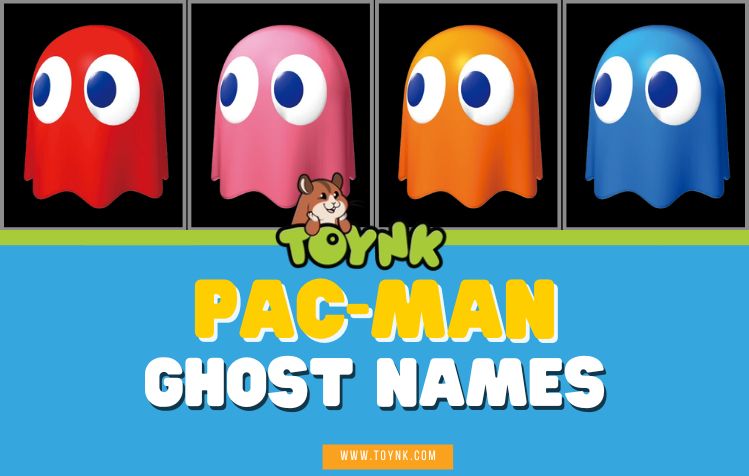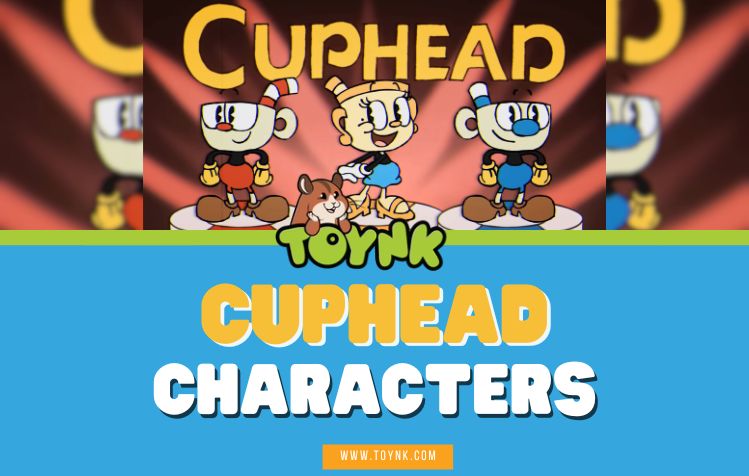Pac-Man, the classic arcade game released in 1980 by Namco, has entertained generations of gamers worldwide. While Pac-Man is iconic, the colorful ghosts chasing him are equally beloved, bringing unique personalities and distinct characteristics that have elevated this simple maze game to legendary status.
But what exactly are these Pac-Man ghost names, and what distinguishes them from each other? In this article, we'll look into the iconic Pac-Man ghosts' names, personalities, and hidden quirks.
Shop The Pac-Man Collection Now
7 Pac-Man Ghost Names & Their Personalities
1. Blinky (The Red Ghost)

Blinky is known as the leader among the Pac-Man ghosts, easily recognizable by his bright red color. Known as "Shadow" in Japan, Blinky aggressively chases Pac-Man throughout the maze, sticking closely to his tail. He gradually becomes faster as the game progresses, intensifying the player's challenge. [1]
His direct approach makes him a persistent threat and often the most challenging ghost to evade, especially in later stages. Among the four ghosts, Blinky represents the idea of relentless pursuit. He is also involved in coordinated behavior with Inky in some versions of the game.
2. Pinky (The Pink Ghost)

Known as "Speedy" in Japan, Pinky attempts to anticipate and cut off Pac-Man's movements rather than pursuing directly. She strategically positions herself ahead of Pac-Man, often four squares in front, effectively trying to trap players who aren't thinking ahead.
Her calculated and tactical movements make Pinky a formidable opponent, particularly for new players. Blinky, Pinky, Inky, and Clyde form the core ghost gang in the original Pac-Man game, each playing a distinct role in chasing Pac-Man.
3. Inky (The Cyan Ghost)

Inky, the cyan-colored ghost, brings an element of unpredictability to the game. Often called "Bashful" in the original Japanese version, Inky uses a complicated algorithm that considers both Pac-Man's and Blinky's positions, resulting in erratic and unpredictable movements.
This unpredictability keeps players on edge, as his paths aren't as straightforward as the other ghosts. Because of this complexity, many players consider Inky the most dangerous ghost. When ghosts turn blue, Inky’s behavior is just as tricky, often drawing players into risky moves.
4. Clyde (The Orange Ghost)

Clyde, humorously known as "Pokey" in Japan, is the wildcard of the group. Unlike the others, Clyde's movements alternate between chasing Pac-Man directly and wandering randomly around the maze. Players may mistakenly view Clyde as harmless because of his random behavior, but this can make him deceptively tricky.
Just when you think he's aimlessly roaming, Clyde can quickly become a threat. Among the four ghosts, Clyde stands out for being the least predictable, next to Inky. He’s one ghost who seems to defy logic entirely.
5. Sue
Sue replaced Clyde in Ms. Pac-Man. Though she shares a similar personality with Clyde, alternating between chasing and random movement, her introduction added variety and freshness to the series.
Sue is often mistaken for Pinky due to her color, but she is her own character, appearing in other games like Jr. Pac-Man and various Pac-Man apps.
6. Funky and Spunky
Featured in Pac-Mania, these ghosts introduced a fresh challenge with their unique movement styles and increased difficulty due to the game's 3D environments. In these versions of the game, the ghosts had new AI and speed attributes, giving players a different kind of chase. Funky and Spunky often appeared in games that featured a battle element or enhanced power pellet design.
7. Lord Betrayus
In "Pac-Man and the Ghostly Adventures," Lord Betrayus became a central antagonist. He controls numerous ghostly minions, expanding the Pac-Man universe beyond classic gameplay. The ghostly adventures storyline takes Pac-Man into settings like the power pellet forest and introduces new monsters, adding depth to the franchise.
Why Are They Different?
Each ghost in Pac-Man has a distinct behavior pattern, making the game both challenging and engaging. Game designer Toru Iwatani designed each ghost’s behavior to avoid predictable gameplay. Blinky aggressively follows Pac-Man, Pinky tries to trap him, Inky moves unpredictably, and Clyde oscillates between random wandering and pursuit.
These different behaviors force players to constantly adapt their strategies, keeping gameplay fresh and preventing repetitive patterns. The ghosts were created not just as obstacles but as characters with purpose.
When Pac-Man eats one of the four power pellets, the ghosts temporarily turn blue, becoming vulnerable. This moment in the game flips the dynamic—Pac-Man can now eat the ghosts for bonus points. During this phase, known as fright mode, players often plan routes to chase and eat as many ghosts as possible. As the game progresses, the blue phase shortens, making it harder to capitalize on the advantage.
Shop The Pac-Man Collection Now
Interesting Trivia About Pac-Man Ghosts

In the original Japanese Pac-Man, the ghosts' names represent their behaviors:
Blinky (Shadow): Chases closely like a shadow.
Pinky (Speedy): Attempts to get ahead of Pac-Man.
Inky (Bashful): Moves erratically due to uncertainty.
Clyde (Pokey): Moves slowly and unpredictably.
The ghosts switch from "chase mode" to "scatter mode," periodically scattering away to give players brief opportunities to escape. This mechanic adds layers of strategy and variety to every level. The switching pattern of the ghost gang keeps the player alert and constantly adapting. Some games also feature moments where just two ghosts appear at the beginning before all four join in.
Clyde is designed as a less logical character, intentionally behaving erratically compared to his counterparts. His movement logic causes him to sometimes head toward Pac-Man, then suddenly retreat and meander. This makes him unique among the individual ghosts and adds to the random feeling he brings to each game.
The Pac-Man ghost names have even appeared in pop culture and modern gaming apps, ensuring their relevance across generations. The maze, the dots, the chase—it’s a formula that still holds up today.
FAQs
Do Pac-Man ghosts have specific patterns or movements?
Yes, each ghost follows specific programming patterns: Blinky chases directly, Pinky tries to trap, Inky moves unpredictably, and Clyde alternates between pursuit and random roaming. These patterns define the game's difficulty curve.
Are Pac-Man ghosts faster than Pac-Man?
Initially, ghosts move slightly slower, but Blinky becomes faster as levels advance, increasing game difficulty. This mechanic is designed to keep the chase thrilling and raise the stakes with each level.
Is there a difference between Pac-Man and Ms. Pac-Man ghosts?
Yes, Ms. Pac-Man replaced Clyde with Sue, who shares Clyde’s general wandering behavior, and the ghosts' AI was also modified for greater unpredictability. Ms. Pac-Man also added new maze designs and introduced faster speeds.
Why is the ghost named Clyde?
Clyde's humorous name emphasizes his distinctively random behavior, intentionally standing out from the other ghosts' patterns. Among the ghost names, his is the most unexpected and quirky.
Why does Pac-Man eat ghosts?
When Pac-Man consumes special flashing dots known as Power Pellets, the ghosts temporarily turn blue, becoming vulnerable so Pac-Man can eat them to score extra points. This is one of the game’s most iconic features, giving players a chance to turn defense into offense.
What happens in Pac-Land?
In Pac-Land and other games in the franchise, Pac-Man explores new environments beyond the classic maze. The ghosts still appear, though their behavior may differ. Some versions include appearances by other ghosts or variants of Blinky, Pinky, Inky, and Clyde.
Are there apps where you can play Pac-Man?
Yes! Many apps now allow players to experience both the original Pac-Man and other games like Pac-Mania, Ghostly Adventures, and Ms. Pac-Man. These include enhanced graphics, online leaderboards, and extra features like power pellet forests and customizable mazes.
Who is Tim in Pac-Man?
While not an official ghost in the core franchise, Tim occasionally appears in fan games or mods as one ghost among other ghosts created for fun or parody. He reflects the creative flexibility fans bring to the Pac-Man universe.
What’s the nickname for the Pac-Man ghost gang?
The ghost gang is sometimes nicknamed "Blinky, Pinky, Inky, and Clyde," or more casually "the four ghosts." In various media and fan circles, they’re referred to as Pac-Man’s rivals, goblins, or even monsters.
Conclusion
The Pac-Man ghosts aren’t simply enemies—they're carefully crafted characters with distinct behaviors, quirks, and personalities. Each ghost's specific movements and strategies contributed significantly to Pac-Man’s lasting popularity.
The next time you play Pac-Man, consider how each ghost behaves differently. Knowing these patterns won't just help you score higher—it'll make your gaming experience richer, more strategic, and infinitely more enjoyable. [2]
So get ready, grab those dots, avoid the monsters, eat the power pellets, and dive deep into the blue—because the chase never ends. And if you’re a true fan, check out Toynk’s Pac-Man collection for awesome merch that brings retro arcade magic to life.
Shop The Pac-Man Collection Now
References:
1. https://pacman.fandom.com/wiki/Blinky
2. https://www.pacman.com/en/



